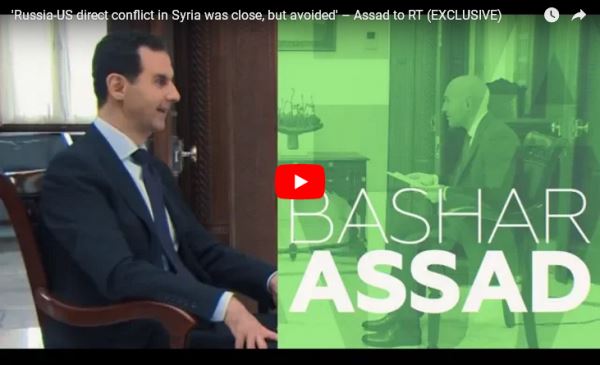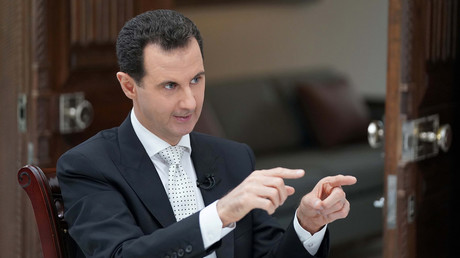Syrian President Bashar Assad says Moscow deterred the West from launching a devastating country-wide air strike last month, and believes that Damascus has nearly won the seven-year war, despite continued US “interference.”
“With every move forward for the Syrian Army, and for the political process, and for the whole situation, our enemies and our opponents, mainly the West led by the United States and their puppets in Europe and in our region, they try to make it farther – either by supporting more terrorism, bringing more terrorists to Syria, or by hindering the political process,” Assad told RT correspondent Murad Gazdiev, during a sit-down interview in Damascus, noting that without outside funding his opponents inside the country could be subdued “within a year.”

After having to switch its support between the various anti-Assad factions, and the recapture of the key cities of Aleppo and Deir ez-Zor by government forces over the past two years, Washington, the Syrian leader believes, is “losing its cards” and can be brought to the negotiating table.
Read more

“Our challenge is how can we close this gap between their plans and our plans,” Assad said.
‘World didn’t buy US chemical weapons story’
The Syrian leader believes, however, that the closer the deadly conflict comes to an end, the more desperate his opponents’ measures become. He cited the alleged Douma chemical weapon attack (“Is it in our interest? Why, and why now?” he asks) as a last-ditch Western attempt to sway international opinion – one that failed.
“They told a story, they told a lie, and the public opinion around the world and in the West didn’t buy their story, but they couldn’t withdraw. So, they had to do something, even on a smaller scale,” Assad said, referring to the joint airstrikes against purported Syrian chemical weapons facilities, carried out on April 14 by the US, UK, and France.
Assad says Moscow also played a role in restraining Washington’s influence and meddling in the region, both generally since its invitation to aid Damascus in September 2015, and in this particular incident.
‘Russia deterred larger-scale attack on Syria’
“The Russians announced publicly that they are going to destroy the bases that are going to be used to launch missiles, and our information – we don’t have evidence, we only have information, and that information is credible information – that they were thinking about a comprehensive attack all over Syria, and that’s why the threat pushed the West to make it on a much smaller scale,” the Syrian president said.
With Western ‘advisers’ deployed alongside their proxy forces in Syria, Assad also thanked Russia for not triggering face-to-face confrontation with the US, which is operating in close proximity both in the air and on the ground.
“We were close to have direct conflict between the Russian forces and the American forces, and fortunately, it has been avoided, not by the wisdom of the American leadership, but by the wisdom of the Russian leadership,” Assad told Gazdiev. “We need the Russian support, but we need at the same time to avoid the American foolishness in order to be able to stabilize our country.”
‘Either you have a country or you don’t have a country’
Despite praising the diplomatic efforts of the Astana peace process, and emphasizing the government’s own drive to win the hearts and minds by restoring order in liberated areas, and initiating a process of reconciliation, Assad says there are still some victories that will have to be won on the battlefield.
“Factions like Al-Qaeda, like ISIS, like Al-Nusra, and the like-minded groups, they’re not ready for any dialogue, they don't have any political plan; they only have this dark ideological plan, which is to be like any Al-Qaeda-controlled area anywhere in this world. So, the only option to deal with those factions is force,” Assad said, emphasizing that there is no stepping back now.
“The more escalation we have, the more determined we’ll be to solve the problem, because you don’t have any other choice; either you have a country or you don’t have a country,” the Syrian president told RT.
(RT)